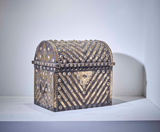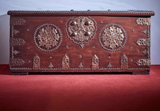STRUCTURAL FEATURES: The 19th century sees a surge in trade between colonial India and Africa, with the island of Zanzibar off the east coast of Africa being an important entry point for traders into various places in Africa. Simultaneously, Arab traders used Zanzibar as the base for slave-trade. Wooden chests would play a pivotal role in the ferrying of traded goods. Similar to tea chests or vanity cases, they are also known as Shirazi or Basra chests as they travelled from India to Shiraz and then onwards to Zanzibar. Brass-studded wooden chests are considered as a symbol of wealth and status, coveted by seamen and rich merchants alike. Smaller chests, akin to a briefcase, could have various tiers on the inside and layered with velvet, were not too heavy and thus easy to move around or travel with.
STYLISTIC FEATURES: A number of wooden chests belonging to the 19th century were lined and studded with decorative elements using brass. Intricate marquetry work, fretwork, ornate finials, and riveted, spiked or braided metal edges are key features. Fittings such as the handles, clasps, hinges, nails and straps are as detailed as the motifs that adorn the surface of the chests. It is also believed that the sailors, during their voyages, added elements such as brass studs in arabesque patterns on their surface to boost their value.
|
Small Dome-shaped Chest
 click to zoom in click to zoom in
|
|
|
|
|
Chest with stud detailing
 click to zoom in click to zoom in |
|
|
|
|
Carved Ornate Chest
 click to zoom in click to zoom in
|
|
|
Courtesy: The Taj Mahal Palace, Mumbai
|
|







